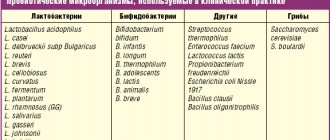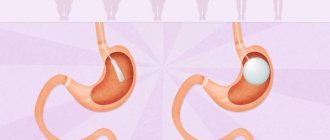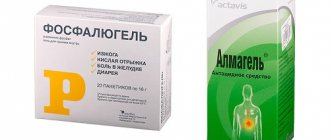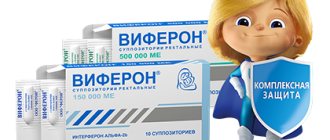The mucous membrane of the stomach, or more precisely, the area of its bottom and body, consists of special cells - parietal, or parietal. These are glandular cells whose main function is to produce hydrochloric acid. If they function normally, exactly as much hydrochloric acid is produced as needed. If its quantity exceeds the needs of the digestive system, the mucous membrane of the stomach and then the esophagus becomes inflamed (gastritis, esophagitis occur), erosions and ulcers form on it, and the patient experiences heartburn, stomach pain and a number of other unpleasant symptoms.
To eliminate all these symptoms, you should reduce the amount of hydrochloric acid produced. For this purpose, drugs of different groups can be used, including H2-histamine receptor blockers. What kind of receptors these are, how the drugs work, indications, contraindications for use, as well as the main representatives of this pharmacological group will be discussed in our article.
Mechanism of action, effects
The parietal cells of the gastric mucosa synthesize and secrete hydrochloric acid.
H2-histamine receptors are located in many glands of the digestive system, including the parietal cells of the gastric mucosa. Their stimulation leads to stimulation of the salivary glands, glands of the stomach and pancreas, and promotes the secretion of bile. The parietal cells of the stomach, the same ones that are responsible for the production of hydrochloric acid, are activated much more than others.
Blockers of H2-histamine receptors disrupt their function and lead to a decrease in the production of hydrochloric acid by parietal cells, especially at night. In addition they:
- stimulate blood flow in the gastric mucosa;
- activate the processes of synthesis of bicarbonate by mucosal cells;
- inhibit pepsin synthesis;
- stimulate the formation of mucus and the secretion of prostaglandins.
The role of histamine in allergic reactions
Histamine is a biologically active substance produced by the body to regulate vital functions (blood circulation, respiration, digestion). It is concentrated in mast cells, white blood cells that are part of the immune system.
Under normal conditions, there is little histamine in the human body and it is inactive. But when certain substances enter the body, their active production begins. When the allergen binds to immunoglobulin, mast cells degranulate (release substances that cause an inflammatory response). Histamine is released, leaves the cells, and the body comes under its influence. It causes:
- hives;
- swelling of the mucous membranes;
- bronchospasms;
- decreased blood pressure;
- digestive disorders;
- confusion;
- slowing down the conduction of nerve impulses.
The first three reactions are allergic. They are the immune system's response to contact with an irritant. Most allergic reactions develop immediately.
How they behave in the body
- Drugs of this group, as a rule, are well absorbed in the initial part of the small intestine.
- The function of H2-histamine blockers is slightly reduced when taken simultaneously with antacids and sucralfate.
- The target in the body (that is, the parietal cells themselves) is not reached by the entire dose of the drug taken orally, but only part of it (in pharmacology, this indicator is called bioavailability). For cimetidine, the bioavailability is 60-80%, ranitidine - 55-60%, famotidine - 30-50%, roxatidine - more than 90%. If an H2-histamine blocker is administered intravenously, its bioavailability tends to 100%.
- After oral administration, the maximum concentration of the drug in the blood is determined after 1-3 hours.
- They pass through the liver, undergoing a number of chemical changes in it, and are excreted in the urine.
- The half-life of ranitidine, cimetidine and nizatidine is 2 hours, famotidine - 3.5 hours.
Classification
H2 histamine receptor blockers are divided according to their pharmacological properties into drugs of the I, II, III, IV and V generations. First generation drugs traditionally include cimetidine. Second-generation drugs include ranitidine, third-generation drugs include famotidine, fourth-generation drugs include nizatidine, and fifth-generation drugs include roxatidine (according to some classifications, roxatidine and nizatidine are classified as third-generation drugs). The drugs lafutidine, ebrotidine, niperotidine, miphentidine, used in clinical practice in a number of countries, are not classified in relation to the generation of HH2 receptor blockers. The clinic also uses a combined drug of ranitidine and bismuth subcitrate, which, according to the international classification, is also classified as H2 histamine blockers.
Indications for use
H2-histamine blockers are used to treat the following diseases:
- reflux esophagitis;
- GERD;
- erosive gastritis;
- peptic ulcer of the stomach and duodenum (after 28 days of treatment, the duodenal ulcer scars in 4 out of five patients, and after 6 weeks - in 9 out of 10 patients; the stomach ulcer scars in three out of five cases after 6 weeks, and in 8-9 out of 10 cases – after 8 weeks of treatment);
- Zollinger-Ellison syndrome;
- functional dyspepsia;
- bleeding from the upper gastrointestinal tract.
Less commonly, as part of complex treatment, these drugs are prescribed to patients with pancreatic enzyme deficiency or urticaria.
It is worth noting that, according to clinical studies, 1-5% of patients are completely insensitive to H2 blockers. When monitoring their pH, they did not show any changes in intragastric acidity. Sometimes such resistance exists to any one representative of the group, and sometimes to all.
H2-blockers of histamine receptors
H2-histamine receptor blockers
(eng.
H2-receptor antagonists
) - drugs intended for the treatment of acid-dependent diseases of the gastrointestinal tract. The mechanism of action of H2 blockers is based on blocking H2 receptors (also called histamine) of the lining cells of the gastric mucosa and, for this reason, reducing the production and flow of hydrochloric acid into the lumen of the stomach. Refers to antiulcer antisecretory drugs.
Types of H2 blockers
The Anatomical Therapeutic Chemical Classification (ATC) in section “A02 Drugs for the treatment of diseases associated with acidity disorders” contains the group: A02BA H2-histamine receptor blockers
A02BA01 Cimetidine A02BA02 Ranitidine A02BA03 Famotidine A02BA04 Nizatidine A02BA05 Niperotidine A02BA06 Roxatidine A02BA07 Raniti dyne bismuth citrate A02BA08 Lafutidine A02BA51 Cimetidine in combination with other drugs A02BA53 Famotidine in combination with other drugs
By Order of the Government of the Russian Federation of December 30, 2009 No. 2135-r, the following H2-histamine receptor blockers are included in the List of vital and essential medicines:
- ranitidine - solution for intravenous and intramuscular administration; injection; film-coated tablets; film-coated tablets
- famotidine - lyophilisate for preparing a solution for intravenous administration; film-coated tablets; film-coated tablets.
From the history of H2-blockers of histamine receptors
The history of H2-histamine receptor blockers begins in 1972, when, under the leadership of James Black, in the laboratory of Smith Kline French in England, after overcoming initial difficulties, a large number of compounds similar in structure to the histamine molecule were synthesized and studied.
Effective and safe compounds identified at the preclinical stage were transferred to clinical trials. The first selective H2 blocker, burimamide, was not effective enough. The structure of burimamide was slightly changed and a more active methiamide was obtained. Clinical studies of this drug showed good efficacy, but unexpectedly high toxicity, manifested in the form of granulocytopenia. Further efforts led to the creation of cimetidine. Cimetidine successfully underwent clinical trials and was approved in 1974 as the first selective H2 receptor blocker drug. This played a revolutionary role in gastroenterology, significantly reducing the number of vagotomies. For this discovery, James Black received the Nobel Prize in 1988. However, H2 blockers do not have complete control over blocking the production of hydrochloric acid, since they affect only part of the mechanism involved in its production. They reduce secretion caused by histamine, but do not affect secretion stimulants such as gastrin and acetylcholine. This, as well as side effects, the effect of “acid rebound” upon withdrawal, guided pharmacologists to search for new drugs that reduce gastric acidity (Khavkin A.I., Zhikhareva N.S.). The figure on the right (A.V. Yakovenko) schematically shows the mechanisms of regulation of the secretion of hydrochloric acid in the stomach. The parietal cell is shown in blue, G is the gastrin receptor, H2 is the histamine receptor, M3 is the acetylcholine receptor.
Still from video Berezhnaya I.V., Kamlygina M.V. Proton pump inhibitors. SIBO as a complication. In the second part of the video M.V. Kamlygina talks about the history of the discovery of histamine, H2-blockers of histamine receptors, and proton pump inhibitors.
H2 blockers are relatively outdated drugs
| Comparison of daily antisecretory activity of H2 receptor blockers (ranitidine) and omeprazole (Maev I.V. et al.) |
H2-blockers in all pharmacological parameters (acid suppression, duration of action, number of side effects, etc.) are inferior to a more modern class of drugs - proton pump inhibitors, however, in a number of patients (due to genetic and other characteristics), as well as for economic reasons , some of them (mostly famotidine, to a lesser extent ranitidine) are used in clinical practice.
Of the antisecretory drugs that reduce the production of hydrochloric acid in the stomach, two classes are currently used in clinical practice: H2-blockers of histamine receptors and proton pump inhibitors. H2 blockers have a tachyphylaxis effect (a decrease in the therapeutic effect of the drug when taken repeatedly), but proton pump inhibitors do not. Therefore, proton pump inhibitors can be recommended for long-term therapy, but H2 blockers cannot. In the mechanism of development of tachyphylaxis, H2 blockers play a role in increasing the formation of endogenous histamine, which competes for H2 histamine receptors. The appearance of this phenomenon is observed within 42 hours from the start of therapy with H2-blockers (Nikoda V.V., Khartukova N.E.).
In the treatment of patients with ulcerative gastroduodenal bleeding, the use of H2-blockers is not recommended; the use of proton pump inhibitors is preferable (Russian Society of Surgeons).
The time within a day during which intragastric acidity rises above 4.0 pH when taking common medications. O60, omeprazole, 60 mg once daily. O30, omeprazole, 30 mg once daily. O20, omeprazole, 20 mg once daily. R3N, ranitidine, 300 mg at bedtime. R150, ranitidine, 150 mg twice daily. F40, famotidine, 40 mg at bedtime. C8N, cimetidine, 800 mg at bedtime. C4Q, cimetidine, 400 mg four times daily. C4B, cimetidine, 400 mg twice daily. C1G, cimetidine, 200 mg 3 times a day and 400 mg at bedtime. ANT, antacid, 150 mmol seven times daily (Bell NJV, Burget D, Howden CW, 1992).
Still from the second part of the video Berezhnaya I.V., Kamlygina M.V. Proton pump inhibitors. SIBO as a complication.
Frame “Mechanism of action of H2-blockers of histamine receptors” from a video lecture for 3rd year students of the Faculty of Medicine of PSPbSMU named after. acad. I.P. Pavlova: Melnikov K.N. Drugs affecting the gastrointestinal tract
On the website in the “Video” section there is a subsection for patients “Popular Gastroenterology” and subsections “For Doctors” and “For Medical Students and Residents”, containing video recordings of reports, lectures, webinars in various areas of gastroenterology for healthcare professionals and medical students.
Resistance to H2 blockers
When treated with both histamine H2 receptor blockers and proton pump inhibitors, 1–5% of patients have complete resistance to this drug. In these patients, when monitoring gastric pH, no significant changes in the level of intragastric acidity were observed. There are cases of resistance to only one group of drugs: 2nd generation (ranitidine) or 3rd generation (famotidine) histamine H2 receptor blockers, or any group of proton pump inhibitors. Increasing the dose in case of resistance to the drug is usually ineffective and requires its replacement with another type of drug (Rapoport I.S. et al.).
pH-gram of the body of the stomach of a patient with resistance to H2-histamine receptor blockers (Storonova O.A., Trukhmanov A.S.)
Comparative characteristics of H2 blockers
Some pharmacokinetic characteristics of H2 blockers (S.V. Belmer et al.):
| Characteristics | Cimetidine | Ranitidine | Famotidine | Roxatidine |
| Bioavailability,% | 60-80 | 50-60 | 30-50 | 90-100 |
| T½, h | 2 | 2 | 3,5 | 6 |
| Therapeutic concentration, ng/ml | 500-600 | 100-200 | 20-40 | 200 |
| Inhibition of acid production, % | 50 | 70 | 70 | 70 |
| Renal excretion, % | 50-70 | 50 | 50 | 50 |
Comparative characteristics of H2 blockers (Kornienko E.A., Fadina S.A.):
| Index | Cimetidine | Ranitidine | Famotidine | Nizatidine | Roxatidine |
| Equivalent doses (mg) | 800 | 300 | 40 | 300 | 150 |
| Degree of inhibition of HCl production over 24 hours (%) | 40-60 | 70 | 90 | 70-80 | 60-70 |
| Duration of inhibition of nocturnal basal secretion (hours) | 2-5 | 8-10 | 10-12 | 10-12 | 12-16 |
| Effect on serum gastrin levels | increases | increases | doesn't change | doesn't change | doesn't change |
| Frequency of side effects (%) | 3,2 | 2,7 | 1,3 | rarely | rarely |
H2 blockers and Clostridium difficile-associated diarrhea
Clostridium difficile
infection is a significant public health problem.
There is evidence of an association between treatment with antisecretory drugs and the development of Clostridium difficile
-associated diarrhea.
There is also an association between H2 blocker therapy and Clostridium difficile
-associated diarrhea.
Moreover, in patients who additionally received antibiotics, the likelihood of developing such diarrhea is much higher. The number of patients required to be treated with H2-blockers to produce one case of Clostridium difficile
-associated diarrhea by day 14 after hospital discharge in patients receiving or not receiving antibiotics was 58 and 425, respectively (Tleyjeh IM et al, PLoS One. 2013 ;8(3):e56498).
Publications for healthcare professionals regarding the treatment of gastrointestinal diseases with H2-blockers.
- Alekseenko S.A., Loginov A.F., Maksimova I.D. The use of small doses of third-generation H2-blockers in the treatment of dyspepsia // Consilium-Medicum. – 2005. – volume 7. – No. 2.
- Okhlobystin A.V. The use of histamine H2 receptor blockers in gastroenterology // RMZh. Diseases of the digestive system. – 2002. – T.4. – No. 1.
- Belmer S.V., Gasilina T.V., Kovalenko A.A. Histamine receptor blockers. Acid-dependent conditions in children / Ed. acad. RAMS V.A. Tabolina. – M. – 1999. – 112 p.
- Khomeriki S.G., Khomeriki N.M. Hidden aspects of the clinical use of H2-blockers // Pharmateka. – 2000. – No. 9. – p. 9–15.
- Rosen R, Vandenplas Y, Singendonk M, et al. Pediatric Gastroesophageal Reflux Clinical Practice Guidelines: Joint Recommendations of NASPGHAN and ESPGHAN. // J Pediatr Gastroenterol Nutr. 2022 Mar;66(3):516-554.
- Rakitin B.V. Main recommendations in the article: Pediatric Gastroesophageal Reflux Clinical Practice Guidelines: Joint Recommendations of NASPGHAN and ESPGHAN. J Pediatr Gastroenterol Nutr. 2022.
- Kolesnikova I.Yu., Volkov V.S. Diagnosis and treatment of acid-related diseases of the digestive tract. Guide for doctors / M.: Publishing House “Medical Information Agency”, 2014. - 432 p.
On the website in the literature catalog there is a section “H2-blockers”, containing articles devoted to the treatment of the gastrointestinal tract with the help of H2-blockers of histamine receptors.
Trade names of H2 blockers
The following H2-blockers of histamine receptors are (have been) registered in Russia:
- active substance
cimetidine :
Altramet, Apo-Cimetidin, Belomet, Histodil, Yenametidin, Neutronorm, Novo-Cimetin, Primamet, Simesan, Tagamet, Ulkuzal, Ulcometin, Cemidin, Cigamet, Cimehexal, Cimedin, Cimet, Cimetidine, Cimetidine Lannacher, Cimetidine-Rivofarm - active substance
ranitidine :
Asitek, Acidex, Acylok, Vero-Ranitidine, Gistak, Zantac, Zantin, Zoran, Raniberl 150, Ranigast, Ranisan, Ranison, Ranitidine, Ranitidine Vramed, Ranitidine SEDICO, Ranitidine-AKOS, Ranitidine-Acri, Ranitidine-BMS , Ranitidine-ratiopharm, Ranitidine-Ferein, Ranitidine hydrochloride, Ranitidine film-coated tablets, Ranitin, Rantag, Rantak, Ranks, Ulkodin, Ulran, Yazitin - active ingredient
famotidine :
Antodin, Blockacid, Gasterogen, Gastrosidin, Kvamatel, Kvamatel mini, Lecedil, Pepsidin, Ulfamid, Ulceran, Famonit, Famopsin, Famosan, Famotel, Famotidine, Famotidine-ICN, Famotidine-AKOS, Famotidine-Acri, Famotidine-Apo , Famocide - active substance
nizatidine :
Axid - active substance
roxatidine :
Roxane - active substance
ranitidine bismuth citrate :
Pyloride
Medicines with the active substances
niperotidine and
lafutidine
are not registered in Russia. The following brands of H2 blockers are registered in the United States:
- prescription: Tagamet 400 (cimetidine), Zantac (ranitidine), Tritec (ranitidine bismuth citrate), Pepcid (famotidine), Duexis (famotidine), Axid (nizatidine), Nizatidin (nizatidine)
- over-the-counter (OTC), differing from prescription ones by a reduced content of active substance and intended for the relief of heartburn: Tagamet HB (cimetidine), Zantac 75 (ranitidine), Pepcid AC (famotidine), Pepcid Complete (famotidine), Axid AR (nizatidine).
In Japan, in addition to the “regular” ones, drugs with the active ingredient lafutidine are registered: Protecadin and Stogar. Back to section
Side effect
First generation H2-histamine blockers, that is, cimetidine, have the greatest number of side effects:
- increased concentrations of prolactin and testosterone in the blood and associated amenorrhea (absence of menstruation), galactorrhea (discharge of milk from the mammary glands), gynecomastia (enlargement of the mammary glands in men), impotence; these effects occur exclusively when taking large doses of the drug for a long time;
- increased levels of AST and ALT (maximum 3 times), extremely rarely - acute hepatitis;
- headaches, fatigue, tendency to depression, confusion, hallucinations; develop mainly in elderly people;
- increase in blood creatinine concentration (maximum 15%);
- decrease in the level of neutrophils and platelets in the blood;
- heart rhythm disturbances.
Due to the fact that the dangers of taking cimetidine outweigh the intended benefits, this drug is generally not used today. It has been replaced by other H2-histamine receptor blockers with a higher safety profile. However, they also have side effects. This:
- bowel disorders (diarrhea, constipation);
- flatulence;
- allergic reactions;
- “rebound phenomenon” - increased production of hydrochloric acid after discontinuation of the drug;
- with long-term (more than 6-8 weeks) use - hyperplasia of ECL cells of the gastric mucosa with the development of hypergastrinemia (increased gastrin levels in the blood).
Symptoms of an allergic reaction
A wide range of symptoms is known, but this does not mean that the same clinical picture occurs upon contact with all allergens. Depending on the type of hypersensitivity, the body reacts differently:
- atopic: rhinitis, conjunctivitis, dermatitis, asthma, Quincke's edema;
- reagin: inflammation of the mucous membranes, autonomic disorders;
- cytotoxic immune: damage to cells and tissues (immune thrombocytopenia, hemolytic anemia, etc.);
- immunocomplex: inflammation of joints, kidneys, skin manifestations.
There are also delayed-type reactions that do not make themselves felt immediately upon contact with the irritant. After two days, the allergen combines with lymphocytes, which leads to the development of an infectious-allergic disease, for example, chronic neurodermatitis.
Preparations and their brief characteristics
Cimetidine (trade names – Histodil, Cimetidine)
First generation drug. It has a large number of side effects, which is why it is not used today and is practically absent from the pharmaceutical network. Previously, it was prescribed orally at a dose of 800-1000 mg in 4, 2 or 1 evening doses or intravenously at 300 mg 3 times a day.
Ranitidine (Gistac, Zantac, Ranigast, Ranisan, Ranitidine and others)
Second generation drug.
Ranitidine... Any grandmother knows what these pills are for. In my experience, this is the favorite remedy for stomach pain of people over 70. This is because during their youth there were no drugs that are more preferable for the treatment of gastritis and stomach ulcers now (we are talking about proton pump inhibitors), but it was this one – ranitidine.
Like cimetidine, it can be used orally or intravenously. For oral administration, tablets of 150 or 300 mg are used. The daily dose is 300 mg, the drug is taken 1-2 times a day. 50 mg (2 ml) is administered into a vein 3-4 times a day.
Ranitidine is much better tolerated than cimetidine, but cases of acute hepatitis have been reported while taking this drug.
Famotidine (Kvamatel, Famotidine)
III generation drug. According to research, it is 7-20 times more effective than ranitidine. Its effect is long-lasting (after oral administration, famotidine acts for 10-12 hours).
As a rule, it is well tolerated by patients both in the treatment of exacerbations and in the case of prophylactic use. There are a minimum of side effects, including minor symptoms from the digestive tract or allergic reactions that do not require discontinuation of the drug.
Can be used in people with alcohol dependence; it does not require a complete cessation of alcohol intake during the treatment period.
Available in the form of tablets of 0.02 and 0.04 g, as well as in ampoules containing 0.01 g of the drug per 1 ml.
Famotidine is usually taken at a dose of 0.04 g per day in 1 (evening) or 2 (morning and evening) doses. 0.02 g is administered intravenously twice a day.
Nizatidine and roxatidine
IV and V generation drugs. Previously used, but today not registered in our country.
How to eliminate allergy symptoms
The more free histamine is released, the more severe the allergic reaction. In some cases it causes inconvenience (constant sneezing, itchy eyes), in others it poses a threat to life (with bronchospasm a person cannot breathe). You can stop the reaction:
- stopping contact with the allergen;
- neutralizing histamine with an antihistamine;
- symptomatic therapy (for example, inhalation to immediately expand the lumens of the bronchi).
In the event of the development of anaphylactic shock, accompanied by a decrease in blood flow and laryngeal edema, it is important to promptly eliminate the threat to life. The set of measures includes the administration of adrenaline and ensuring air flow into the lungs (intubation).
Ranitidine or Omez: which is better?
As it turns out, many Internet users are very interested in this question.
Speaking more generally, comparing not these 2 specific drugs, but the pharmacological groups to which they belong (H2-histamine blockers and proton pump inhibitors), we can say the following...
Of course, the latter (including Omez) have a number of advantages. These are modern drugs that effectively suppress the production of hydrochloric acid, act for a long time, are well tolerated by patients, have virtually no side effects on them, and so on.
However, H2-histamine receptor blockers have their admirers who would not exchange their favorite Ranitidine or Famotidine for any Omez









